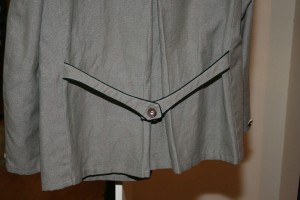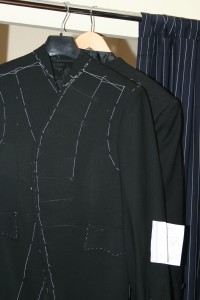
My thanks to all of you that either commented here or emailed me about my decision on the polo coat I am having designed at Graham Browne. The response was fairly unanimous: go for double breasted as it best fits the classic style of the coat, and it won’t look too busy because the full pleat and belt will be the other side to the pockets and double breast.
So that’s the final commission. A double-breasted polo coat with raised seams, patch pockets, split sleeve, turn-back cuffs, welted breast pocket and full pleat in the back to be fastened with a one-piece belt.
The belt will be a single, detachable piece that is attached with six buttons sewn onto the coat – three on either side. Although we only need three settings, six buttons are needed to stop any setting being lopsided. (It also gives us half settings if desired at any point.)
The advantage of a detachable piece of fabric is that it can more easily fold the pleat in on itself, rather than create other folds in the fabric near to the side seams. As can be seen on the picture of an Austrian jacket (being made by Graham Browne for a client), a two-piece design necessarily pulls the side seams first, creating unwanted folds. At the coat’s widest setting, a detachable belt will also keep the pleat open. (With this jacket illustrated the pleat and belt are more decorative, so other folds are less of a concern.)
The size of the pleat will be eight inches at the waist (four inches wide when closed, doubling back on itself, to make a total length of eight and the possibility of opening to eight at the coat’s biggest setting). It will flare out towards the bottom, so that there is still ample room to walk when the pleat is closed. Probably with a maximum width of 16 inches in the pleat at the very bottom.
The length of the coat will be a couple of inches below the knee – or as this is often measured, 13.5 inches off the ground. That is still quite long, and the old standard of 11 or 12 inches from the ground would seem very long to most men.
To material. The choices were between camel hair and cashmere, J&J Minnis or Harrisons. The four shades of camel hair available from Harrisons are shown above, with the Minnis options shown at the very top of this piece – the shade I went with being uppermost. The weights are fairly consistent, between 18 and 21 ounces. The tan Minnis that I selected was 20 oz.
Neither cashmere or camel hair are meant to wear well, but as this will not be my first-choice coat for business, and as I often cycle to work, it will not get very heavy wear.
The lining is a cream, heavy twill, of the type usually used for military linings and so very tough. I was tempted by cream buttons as well, but in the end went for the mottled brown you see on the cloth below. Next post at the first fitting in a week. Then we can see how the belt works and how best to fit the shoulders over a big jacket.
Oh, and finally I thought readers might be interested to see the formalwear that Graham Browne is making for the Lord Mayor of London. The front jacket is a new piece that is being made in a lighter-weight fabric for day-to-day wear rather than functions. Behind it is the heavier, formal version.





























i like the style. a unique style good color combination.
______________
double breasted blazer